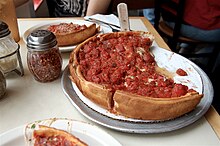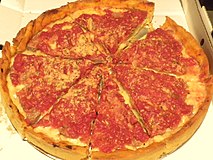Chicago-style pizza
 Deep-dish pizza from Pizzeria Uno | |
| Type | Pizza |
|---|---|
| Place of origin | United States |
| Region or state | Chicago, Illinois |
| Main ingredients | Pizza dough, tomato sauce, cheese |
| Part of a series on |
| Pizza |
|---|
 |
Chicago-style pizza is pizza prepared according to several different styles developed in Chicago, widely referred to simply as deep dish pizza due to its cooking style. The pan in which it is baked gives the pizza its characteristically high edge which provides ample space for large amounts of cheese and a chunky tomato sauce. Chicago-style pizza may be prepared in deep-dish style and as a stuffed pizza.[1][2]
Deep-dish pizza[]
According to Tim Samuelson, Chicago's official cultural historian,[3] there is not enough documentation to determine with certainty who invented Chicago-style deep-dish pizza.[4] It is often reported that Chicago-style deep-dish pizza was invented at Pizzeria Uno in Chicago, in 1943,[5] by Uno's founder Ike Sewell. However, a 1956 article from the Chicago Daily News asserts that Uno's original pizza chef Rudy Malnati developed the recipe,[6] and Michele Mohr from the Chicago Tribune reports that the menu at Rosati's Authentic Chicago Pizza has included deep-dish since it opened in 1926, according to the descendants of Saverio Rosati.[7]
The primary difference between deep-dish pizza and most other forms of pizza is that, as the name suggests, the crust is very deep, creating a very thick pizza that resembles a pie more than a flatbread. Although the entire pizza is very thick, in traditional Chicago-style deep-dish pizzas the crust itself is thin to medium in thickness.
Deep-dish pizza is baked in an iron skillet or a round, steel pan that is more similar to a cake or pie pan than a typical pizza pan. The pan is oiled to allow for easy removal as well as to create a fried effect on the outside of the crust. In addition to ordinary wheat flour, the pizza dough may contain cornmeal, semolina, or food coloring, giving the crust a distinctly yellowish tone. The dough is pressed up onto the sides of the pan, forming a bowl for a very thick layer of toppings.
The thick layer of toppings used in deep-dish pizza requires a longer baking time (typically 30-45 minutes), which could burn cheese or other toppings if they were used as the top layer of the pizza.
Because of this, the toppings are assembled "upside-down" from their usual order on a pizza. The crust is covered with cheese (generally sliced mozzarella), followed by various meat options such as pepperoni or sausage, the latter of which sometimes is in a solid patty-like layer. Other toppings such as onions, mushrooms, and bell peppers are then also used.
An uncooked sauce, typically made from crushed canned tomatoes, is added as the finishing layer; though sometimes, a sprinkling of Parmesan cheese is added for extra flavor.[5]
It is typical that when ordered for carry-out or delivery, the pizza is uncut, as this prevents moisture from the sauce and toppings from soaking into the crust, causing the pie to become soggy.
Some Chicago deep-dish pizza restaurants ship their pizzas, partially baked and frozen, within the continental United States.[8][9]
- Deep-dish pizza

Californian imitation of Chicago-style deep-dish pizza

Deep-dish pizza from Lou Malnati's
Stuffed pizza[]

By the mid-1970s, two Chicago chains, Nancy's Pizza, founded by Rocco Palese,[10] and Giordano's Pizzeria, operated by brothers Efren and Joseph Boglio, began experimenting with deep-dish pizza and created the stuffed pizza.[11] Palese based his creation on his mother's recipe for scarciedda, an Italian Easter pie from his hometown of Potenza.[12] Chicago Magazine articles featuring Nancy's Pizza and Giordano's stuffed pizza popularized the dish.
Stuffed pizzas are often even deeper than deep-dish pizzas, but otherwise, it can be hard to see the difference until it is cut into.
A stuffed pizza generally has much deeper topping density than any other type of pizza. As with deep-dish pizza, a deep layer of dough forms a bowl in a high-sided pan and the toppings and cheese are added. Then, an additional layer of dough goes on top and is pressed to the sides of the crust. At this stage, the thin dough top has a rounded, domed appearance.
Pizza makers often poke a small hole in the top of the "lid" to allow air and steam to escape while cooking, primarily so that the pizza does not explode. Usually, but not always, tomato sauce is ladled over the top crust before the pizza is baked.
Thin-crust pizza[]

There is also a style of thin-crust pizza found in Chicago and throughout the rest of the Midwest. The crust is thin and firm enough to have a noticeable crunch, unlike a New York-style pizza.
This pizza is cut into squares, also known as "tavern-style" or "party cut", as opposed to wedges.[13][14][15]
Among locals, thin-crust outsells the more widely known deep-dish style.[16][17]
Toppings[]
The typical toppings commonly found on pizzas in most of North America (i.e. sausage, pepperoni, onions, mushrooms, etc) are also standards in Chicago area pizzerias; however, a survey in 2013 indicated that while the most popular pizza topping in the rest of most of the United States, is pepperoni,[18][19] in Chicago, the most popular topping is Italian sausage.[20] In addition to standard toppings, many local pizzerias also offer Chicago-specific topping options such as Italian Beef and giardinera.
See also[]
References[]
- ^ Ali, Tanveer; Ludwig, Howard (January 13, 2015). "A Guide to Chicago Pizza: From Deep-Dish to Tavern-Style and Beyond" Archived 2016-01-01 at the Wayback Machine, DNAinfo. Retrieved January 2, 2016.
- ^ Kindelsperger, Nick (June 2, 2014). "The Best Deep Dish Pizza in Chicago" Archived 2016-01-06 at the Wayback Machine, Serious Eats. Retrieved January 2, 2016.
- ^ Borrelli, Christopher. "Tim Samuelson: Chicago's cultural historian". chicagotribune.com. Retrieved 2017-04-09.
- ^ "Who Invented Deep Dish?", Chicago Tribune, February 18, 2009. Retrieved January 2, 2016.
- ^ Jump up to: a b Who Cooked That Up? Archived May 8, 2007, at the Wayback Machine
- ^ "Pizano's Pizza and Pasta – About Us – The Best Chicago-Style Pizza and Italian Restaurant". www.pizanoschicago.com. Archived from the original on 2018-09-29. Retrieved 2017-04-09.
- ^ Mohr, Michele (October 22, 1995). "Rosati Family is Dividing Up the Pie". Chicago Tribune. Retrieved June 29, 2019.
- ^ Zimmerman, Karla; Cavalieri, Nate (2008). Chicago: city guide. Lonely Planet. p. 122. ISBN 1-74104-767-6.
- ^ Lou Malnati's Deep Dish Pizza
- ^ Chu, Louisa (September 19, 2016). "Family's Stuffed-Pizza Dynasty Began with a Fight". Chicago Tribune. Retrieved September 21, 2016.
- ^ Pollack, Penny; Jeff Ruby (2005). Everybody Loves Pizza. Emmis Books. p. 33. ISBN 1-57860-218-1.
- ^ "Our Story". Nancy's Pizza. Archived from the original on 2018-10-23. Retrieved 2017-04-09.
- ^ Vettel, Phil; Kevin Pang (2009-07-23). "Pizza slices: Two foodies debate the merits of wedge versus 'party cut'". Chicago Tribune. Chicago, IL: Tribune Company. Archived from the original on 2009-07-26. Retrieved 2009-07-23.
- ^ Chahwala, Jaison (March 13, 2017). "20 Great Spots to Taste Real Chicago Pizza: Tavern-Style Thin Crust". Eater Chicago. Retrieved March 13, 2017.
- ^ McClelland, Edward (June 30, 2020). "Tavern Style Isn't Just Chicago's Signature Pizza, but Its Signature Food". Chicago Magazine. Retrieved February 26, 2021.
- ^ Rousseau, Caryn (2014-09-19). "It's not all deep-dish pizza in Chicago". The Detroit News. Retrieved 2017-01-17.
- ^ John, Derek (December 20, 2013). "Deep Dish or Thin Crust? Even Chicagoans Can't Agree". NPR. Retrieved March 6, 2018.
- ^ Lutz, Ashley (October 10, 2013). "Here's a Pie Chart of the Most Popular Pizza Toppings". Business Insider. Retrieved August 23, 2017.
- ^ "The Top 10 Most Popular Pizza Toppings". Huffington Post. November 12, 2013. Retrieved August 23, 2017.
- ^ Kindelsperger, Nick (August 21, 2017). "Why Are Chicagoans So Obsessed with Italian Sausage on Pizza? An Investigation". Chicago Tribune. Retrieved August 23, 2017.
Further reading[]
- Bruno, Pasquale, Jr. (1983). The Great Chicago-Style Pizza Cookbook. McGraw-Hill Companies Inc. ISBN 0809257300.
- Ruby, Jeff (July 2010). "The 25 Best Pizzas in Chicago". Chicago.
- Food and drink introduced in 1943
- American pizza
- Cuisine of Chicago
- Cuisine of the Midwestern United States
- Pizza styles
- Stuffed dishes

